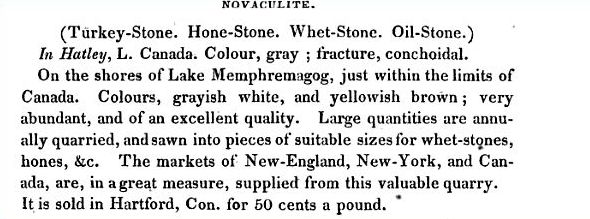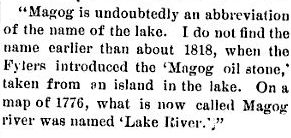Results 1 to 10 of 57
Thread: History of the "Magog Oilstone"
Hybrid View
-
10-15-2012, 01:08 AM #1Historically Inquisitive



- Join Date
- Aug 2011
- Location
- Upstate New York
- Posts
- 5,780
- Blog Entries
- 1
Thanked: 4249
Some more information about the Magog Oilstone.



I guess the British didnt feel they needed a rival in the stone industries and stop the quarry!

Last edited by Martin103; 10-15-2012 at 01:27 AM.
-
The Following 5 Users Say Thank You to Martin103 For This Useful Post:
AljuwaiedAK (08-10-2015), doorsch (12-26-2014), Hirlau (12-25-2014), Margeja (10-15-2012), regularjoe (10-16-2012)
-
10-15-2012, 02:38 AM #2

Wow that's really cool! Thanks for posting it!
With today's synthetics, I doubt that that quarry will ever be re-opened, but I sure would like to have one!David
-
10-15-2012, 03:21 AM #3

Wow! So I thought I would look at some land prices out there - short of 1.5 Million... forget about it! Wow.
David
-
10-15-2012, 10:25 AM #4

Very interesting. I would sure like to have one of those.
Once, washita stones were found to also be superior to the Turkish oilstones and much more expensive, and Charnleys were thought to be inferior compared to the competition and really cheap. From what I understand from those books, a "good" stone was good because of its speed. And, even hard Arkansas were once sold as razor stones.
If you found it, it will definitely worth it, but I don't think it will be the miraculous razor hone.
-
10-15-2012, 03:29 PM #5
-
10-15-2012, 06:10 PM #6Senior Member

- Join Date
- Mar 2009
- Posts
- 1,211
Thanked: 202
Great reading. Thank you for sharing it.
-
The Following User Says Thank You to adrspach For This Useful Post:
OCDshaver (10-11-2018)
-
10-15-2012, 11:55 PM #7Historically Inquisitive



- Join Date
- Aug 2011
- Location
- Upstate New York
- Posts
- 5,780
- Blog Entries
- 1
Thanked: 4249
Last edited by Martin103; 10-16-2012 at 12:19 AM.
-
10-16-2012, 02:17 AM #8

I bet if we could quarry a bit, there would be buyers.
David
-
10-16-2012, 06:32 AM #9Senior Member

- Join Date
- Mar 2009
- Posts
- 1,211
Thanked: 202
-
04-14-2015, 02:20 AM #10Senior Member


- Join Date
- Jul 2011
- Posts
- 2,110
Thanked: 458
Only about 2 1/2 years late here, but washitas were stones sold to joiners and carpenters. One shop session with one (and no other stones) illuminates quickly why they were so valued for woodwork and charnleys were not. A good charn is a capable razor finisher, and only the very fine washitas are. Refreshing a plane iron or chisel is something that can be done every 15 or 20 minutes in heavy use, and the amount of material to remove is probably 50 times what has to come off of a razor.
Before that, the English had sandstone grindstones to use, and a lot of slow cutting stones on top of that. It's by luck that the washita is ideally suited to cut steel about as hard as sheffield steel of the mid 1800s. Any harder, and the stones get slow cutting, any softer, and they cut too deeply and the edge isn't that fine. But at the hardness of the iron in the long plane in this video ( an old laminated butcher iron), just perfect.


 63Likes
63Likes LinkBack URL
LinkBack URL About LinkBacks
About LinkBacks






 Reply With Quote
Reply With Quote
 I don't think a miraculous razor hone exists! There are some dudes who are miraculous with a hone though... some of them even post on this site
I don't think a miraculous razor hone exists! There are some dudes who are miraculous with a hone though... some of them even post on this site 